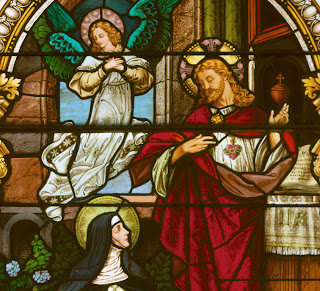
As you probably know, the Jesuit St. Claude la Colombiere was the spiritual director to St. Margaret Mary Alacoque, who received the visions of the Sacred Heart in Paray-le-Monial in France. In a vision, Jesus was said to have told Margaret Mary, who was having a hard time getting anyone in her convent take her seriously, that he would send her his "faithful servant and perfect friend." A short time afterwards, Claude, on his "tertianship" assignment (the last stage of formal Jesuit training) showed up at her convent to be a spiritual director. In him she confided her experiences in prayer, which Fr. Claude saw as authentic. By the way, I've always thought that being the "faithful servant and perfect friend" of Jesus is a good way of expressing the goal of every Christian life.
Since then, the Sacred Heart has been a devotion at the heart of the mission and spirituality of the Society of Jesus. But lately, it's been seen, unfortunately, as "outmoded" by the Catholic world in general. That's too bad: It's a powerful symbol of the Love of God that needs to be recovered in a world filled with hatred and bitterness. Here are two superb resources for meditation on the Sacred Heart. The first is an essay from the magazine (later collected in a book on devotions called Awake My Soul) by Christopher Ruddy, a theologian. Here's my favorite part:
"I did not grow up with any devotion to the Sacred Heart, and it is only in the last few years, as I have struggled with vocation and the demands of family life, that the practice has spoken to my own heart: the fearful heart that paralyzes me when I think of the future, rendering me unable to open myself in trust to God; the cramped heart that refuses to admit my wife and infant son, but clings to my own prerogatives, choosing to watch Peter out of the corner of my eye as I read the morning newspaper rather than get on the floor and play with him; the oblivious heart that holds forth at dinner on the recording history of The Beatles’s Abbey Road, but forgets to ask Deborah how her class went that afternoon. At times like these I wonder, have I really let into my life those I love so much? Have I gone out to them? Are they part of my flesh or merely fellow travelers?
On a particularly difficult afternoon last summer, I took Peter for a walk. We wound up at a church in our neighborhood, and, almost unable to bear the despair and self-loathing that was consuming me, I went in to pray. I lit a candle before Mary for my wife and one for myself before Joseph. Almost accidentally I stopped in front of a wood-carving of the Sacred Heart. Caught somewhere between rage and tears, I looked up at the heart and, for the first time, saw beyond the barbed-wire crown of thorns encircling it, into its gentleness. A prayer rose up in me, “Jesus, give me a bigger heart.” I looked at Peter in shame and in hope, and I went out into the day.
I remain irritable and irritating. I continue to struggle with a stoniness that shuts out so many. I know ever more clearly my deep sinfulness. But in continuing to pray to the Sacred Heart, I have also come to know God’s still deeper mercy. I am strengthened by a heart pierced but unvanquished. I am welcomed by a heart that knows only tenderness and so makes me tender. I look on that pulsing, fleshy heart: courageous and vulnerable, compact and capacious, never one without the other."
The second is from Pedro Arrupe, SJ, the former superior general, from a beautiful 1981 talk:
"In recent years the very expression ‘Sacred Heart’ has constantly aroused, from some quarters, emotional, almost allergic reactions, perhaps in part as a reaction against certain means of presentation and terminologies more suited to the tastes of an earlier time. Therefore it seemed to me to be advisable to allow a little time to pass, in the certainty that this attitude, which is emotional rather than rational, should die down somewhat.
I have always entertained the conviction that the high value of this profound spirituality would not be long in reestablishing itself in the esteem of all. For it is a spirituality which successive Roman Pontiffs have classed as ‘a supreme spirituality’. It is, moreover one which makes use of a biblical symbol, the heart, which itself is a ‘source word’ (Urwort).
For this reason, and very much in spite of myself, I have spoken and written relatively little about this theme, although I have often dealt with in more personal conversations, and in this devotion I myself possess one of the deepest sources of vitality for my interior life."
Happy Feast of the Sacred Heart.
James Martin, SJ







